Money is more than just paper and ink. It’s a symbol of value, a medium of exchange, and a crucial element of the modern economy. But have you ever wondered how this essential component of daily life is created? The process of making U.S. currency is a fascinating blend of art, science, and technology, involving intricate designs, precise printing techniques, and advanced security measures.
In this article, we’ll embark on a journey through the entire currency production process. From the initial design sketches to the final packaging, each step is vital in creating the bills that end up in wallets and cash registers across the country. Our exploration will take us through various stages, including designing, engraving, siderography, platemaking, and the unique combination of paper and ink used. We’ll delve into the complex printing processes, such as offset and plate printing, and examine the meticulous inspection procedures that ensure each bill is perfect.
Additionally, we’ll look at the advanced technologies used in the Currency Overprinting Processing Equipment (COPE) and Large Examining Printing Equipment (LEPE), which play crucial roles in modern currency production. Finally, we’ll see how the finished product is prepared for distribution to banks and financial institutions.
Whether you’re a student, a curious reader, or someone interested in the behind-the-scenes workings of everyday objects, this article will provide a comprehensive and accessible overview of how U.S. currency is made. So, let’s dive into the fascinating world of money production and discover the art and science behind every dollar bill.
Designing U.S. Currency: A Blend of Art and Security
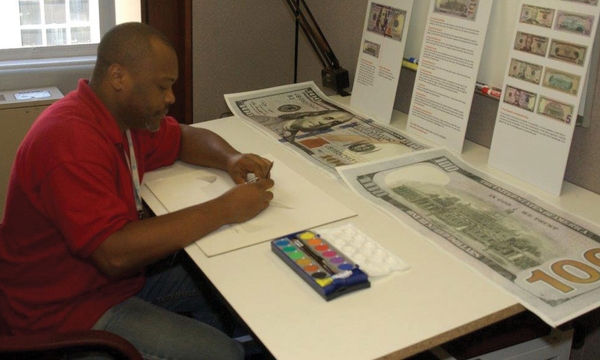
Conceptualization and Inspiration
The design process of U.S. currency begins with a fusion of artistic vision and practical considerations. Teams comprising artists, designers, and security experts come together to brainstorm and conceptualize new ideas. They draw inspiration from the rich tapestry of American history, culture, and symbols, ensuring that each bill reflects the nation’s heritage and values. The selection of portraits and national icons is particularly crucial, as these elements not only embody the country’s identity but also aid the public in recognizing authentic currency.
Collaboration for Security
A key aspect of the design phase is the integration of advanced security features, a task that requires close collaboration between designers and security experts. This partnership is essential to embed features like watermarks, security threads, and color-shifting ink. Each of these elements plays a vital role in making the currency secure against counterfeiting. Watermarks and security threads, for instance, are unique to each denomination and are strategically placed to be visible against light. Color-shifting ink adds an additional layer of security, changing color when the bill is tilted.
Microprinting and Aesthetic Details
Microprinting is another sophisticated technique employed in the design. This involves embedding tiny, nearly invisible text into the design, a feature extremely difficult for counterfeiters to replicate. Alongside these security measures, designers also focus on the aesthetic appeal of the currency. They incorporate intricate patterns, fine lines, and artistic elements that not only enhance the visual appeal but also serve as additional barriers to counterfeiting.
Digital Design and Prototyping
The advent of digital technology has transformed currency design. Digital tools enable designers to exercise precise control over every aspect of the design, ensuring accuracy and consistency. Prototyping is an integral part of this phase, where designs are rigorously tested for their security efficacy, durability, and practicality in everyday transactions.
Feedback and Legal Compliance
Before finalization, currency designs often undergo revisions based on feedback from government officials, historians, and occasionally the public. This iterative process ensures that the designs are not only aesthetically pleasing and secure but also compliant with legal and regulatory standards. The final design represents a harmonious blend of artistic expression and cutting-edge security technology, symbolizing both national pride and the evolution of currency production methods.
Engraving: Crafting the Blueprint of Currency
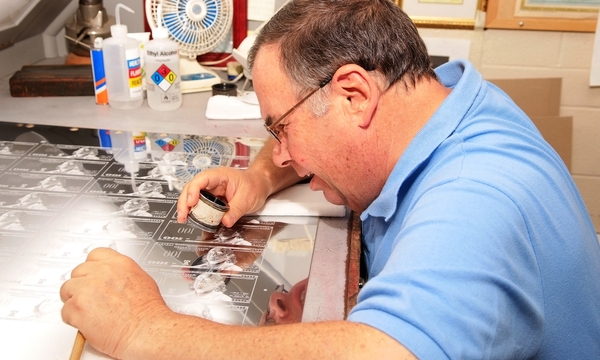
The Evolution of Engraving Techniques
Engraving is a pivotal step in currency production, where the artistic designs are transformed into tangible forms for printing. Historically, this was an entirely manual process, with master engravers meticulously carving the designs into metal plates. Today, while the fundamental principles remain, the method has evolved significantly. Digital engraving, using computer-aided design (CAD) tools, has become the standard. This shift not only enhances precision and consistency but also significantly speeds up the production process, allowing for quicker modifications and adaptations of the designs.
The Role of Engraving in Detailing
Engraving is crucial for adding depth, texture, and tactile features to the currency’s design elements. This includes the fine lines in portraits, intricate background patterns, and subtle design elements that are integral to both the aesthetic appeal and security of the currency. The tactile features introduced during the engraving process are not just for security; they also aid visually impaired individuals in distinguishing between different denominations.
Balancing Artistry and Security
The engraving process is a delicate balance between artistry and security. The engraved plates are used for printing the currency, and thus, every minute detail matters. The precision of engraving directly impacts the effectiveness of security features like microprinting and fine line work, which are essential in preventing counterfeiting. The engravers, therefore, play a critical role in ensuring that each security feature is accurately represented while maintaining the artistic integrity of the original design.
Modern Engraving and Quality Control
In the era of digital engraving, quality control has become more manageable yet more sophisticated. Digital tools allow for exact replication of the design on the metal plates, ensuring uniformity across all currency notes. This uniformity is crucial for both the public’s trust in the currency and for ease of use in automated currency handling systems, like ATMs and sorting machines.
The Final Step Before Printing
Once the engraving process is complete, the plates are ready for the next stage of currency production: printing. The engraved plates serve as the master templates from which millions of currency notes will be printed. The quality, precision, and security of the engraving set the stage for the entire printing process, underscoring its importance in the journey of currency production.
Siderography: Ensuring Consistency in Currency Printing
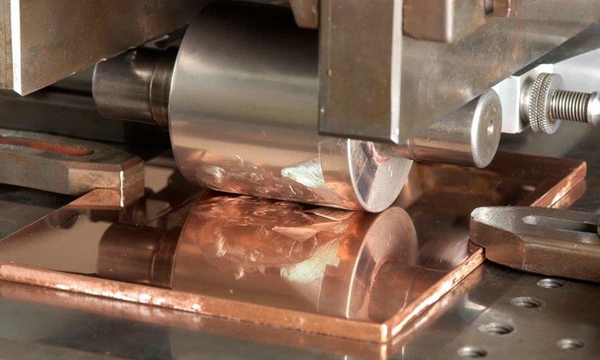
The Essence of Siderography
Siderography is a critical but often less-known stage in the currency production process. It involves transferring the engraved images onto a master printing plate. This step is essential for maintaining consistency and precision across all currency notes.
Transferring Engravings to Printing Plates
The process begins with the master die, which is the original engraved piece. Siderography technicians use this die to create a master plate, which will then be used to produce numerous identical printing plates. The transfer process must be executed with extreme precision to ensure that every detail of the engraving is accurately replicated on the master plate.
Ensuring Precision and Quality
The key to siderography is its ability to produce printing plates that are exact replicas of the master die. This precision is crucial for maintaining the integrity of the currency’s design and security features. Any deviation, no matter how small, could compromise the effectiveness of these features and potentially make the currency vulnerable to counterfeiting.
The Role of Siderography in Security
Siderography plays a significant role in the currency’s security. By ensuring that each printing plate is an exact replica of the original engraving, siderography helps maintain the consistency of security features like microprinting and intricate line work across all notes. This uniformity is essential for both public trust and for the effectiveness of automated verification systems used by banks and other financial institutions.
The Bridge to Mass Production
Once the master plate is created and verified for accuracy, it becomes the blueprint for mass-producing currency notes. The plates produced from this master are used in high-speed printing presses, each capable of printing thousands of sheets per hour. Siderography, therefore, serves as the bridge between the meticulous art of engraving and the high-speed world of modern printing, playing a pivotal role in the journey of currency from design to distribution.
Platemaking: The Foundation of Currency Printing
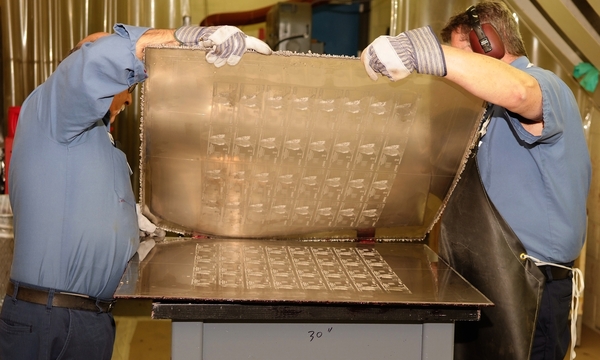
Crafting the Printing Plates
Platemaking is a crucial stage in currency production, where the master plates created during siderography are used to produce the actual printing plates. These printing plates are the tools that will directly imprint the currency’s design onto the paper.
Techniques for Different Denominations
Each denomination of currency has its unique design and security features, which necessitates the creation of specific plates for each denomination. The process involves meticulous craftsmanship to ensure that every detail of the design, including intricate patterns and security elements, is accurately captured on the plates.
Ensuring Durability and Precision
The plates must not only be precise in their replication of the design but also durable enough to withstand the rigors of the printing process. Currency printing involves high pressures and speeds, and the plates are repeatedly used to print large volumes of notes. Therefore, they are typically made from robust materials capable of maintaining their integrity over thousands of impressions without degrading the quality of the print.
The Role of Platemaking in Security
The precision in platemaking is vital for maintaining the currency’s security. Any inconsistency or error in the plates could compromise the effectiveness of security features, making the notes susceptible to counterfeiting. The plates must perfectly replicate the security elements designed in the earlier stages, such as microprinting, intricate line work, and specific tactile features.
Preparing for the Printing Process
Once the plates are created and tested for accuracy and durability, they are ready for the next phase – the actual printing of the currency. The platemaking process sets the stage for this crucial step, ensuring that the currency that reaches the public is not only aesthetically pleasing but also meets the highest standards of security and quality. The transition from platemaking to printing marks the move from the preparatory stages of currency production to the actual creation of the physical notes.
Paper and Ink: The Canvas and Palette of Currency
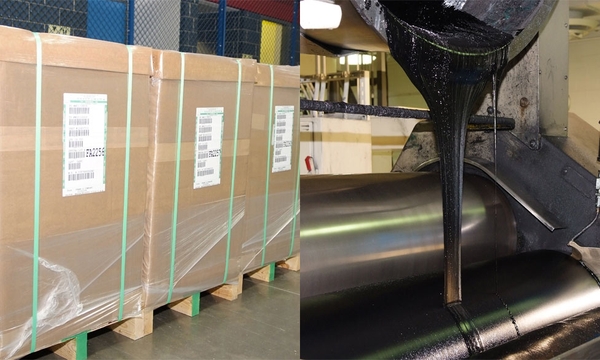
The choice of paper and ink in currency production is as crucial as the design and printing processes. These materials are not only the canvas and palette for the currency but also key elements in ensuring its durability and security.
The Unique Paper Blend
U.S. currency does not use standard paper; it is made from a unique blend of cotton and linen. This blend gives the currency a distinct feel and a high level of durability, allowing it to withstand the wear and tear of daily use. The paper is also embedded with various security features during its production, such as watermarks and security threads, which are integral to the currency’s design and security.
Special Ink Formulations
The ink used in currency printing is not like regular ink. It is specially formulated to be long-lasting and resistant to fading. The ink’s composition is a closely guarded secret, varying for different elements of the currency’s design. For instance, the ink used for the main images and text might differ from the ink used for the security features, like color-shifting ink, which changes color when viewed from different angles.
Contribution to Anti-Counterfeiting Measures
The combination of special paper and ink plays a significant role in the currency’s security. The unique feel of the paper, along with the distinctive properties of the ink, makes it difficult for counterfeiters to replicate. Additionally, the embedded security features in the paper, combined with the specialized ink, add layers of complexity that safeguard against counterfeiting.
Ensuring Quality and Consistency
The quality of the paper and ink is rigorously tested to ensure consistency across all currency notes. This consistency is vital not only for maintaining the public’s confidence in the currency but also for the effective operation of automated handling systems, such as ATMs and sorting machines.
The paper and ink used in U.S. currency are as much a part of its identity as the designs printed on them. They contribute to the overall aesthetic, tactile feel, and, most importantly, the security and longevity of the currency. As we move to the printing stages, these materials will play a pivotal role in bringing the intricate designs and security features to life.
Offset Printing: Laying the Foundation for Currency Design
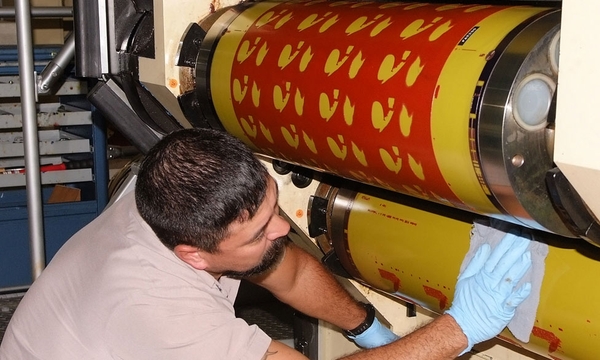
Offset printing is the initial phase in the currency printing process, where the background colors and patterns are applied to the paper. This stage is crucial for setting the stage for the more detailed printing that follows.
The Process of Offset Printing
In offset printing, the inked image is transferred (or “offset”) from a plate to a rubber blanket, and then to the printing surface – the unique currency paper. This method is highly efficient for consistently producing high-quality images. It’s particularly effective for laying down uniform backgrounds and subtle color variations, which are essential for both the aesthetics and security of the currency.
Adding Background Colors and Patterns
The primary role of offset printing in currency production is to apply the background colors and patterns. These backgrounds are not just for visual appeal; they also include subtle security features. For instance, the intricate patterns and color gradients can act as a deterrent to counterfeiting, as they are difficult to replicate accurately without access to specialized printing technology.
Importance in the Multi-Step Printing Process
Offset printing is the first step in a multi-stage printing process. It lays the groundwork for subsequent printing stages, such as intaglio (or plate printing), where finer details and tactile features are added. The quality and precision of offset printing are crucial for ensuring that these later stages are successful. Any misalignment or inconsistency in this phase can affect the overall quality and security of the finished currency note.
Ensuring Consistency and Quality
Throughout the offset printing process, stringent quality control measures are in place. The printed sheets are continuously monitored for consistency in color, clarity, and alignment. This level of scrutiny ensures that each batch of currency paper meets the exact standards required before moving on to the next phase of printing.
Offset printing, with its blend of efficiency and precision, plays a foundational role in currency production. It sets the stage for the intricate and detailed work that follows, ensuring that the final product is not only visually striking but also meets the highest standards of security and quality.
Plate Printing: Adding Detail and Security to Currency
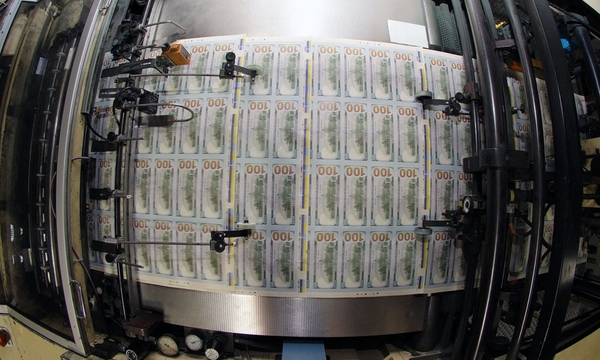
Plate printing, also known as intaglio printing, is a crucial stage in the currency production process. This method is responsible for adding the fine details, including the portraits, text, and intricate designs, as well as important tactile features to the currency notes.
The Intaglio Printing Process
In plate printing, the ink is applied to engraved plates, and then transferred under high pressure to the currency paper. This process not only imparts the detailed design onto the paper but also creates a raised texture that can be felt by touch. The raised texture is a key security feature, as it is difficult to replicate without the specialized equipment used in this process.
Adding Crucial Design Elements
Plate printing is where the currency’s most recognizable features are added – the portraits, historical images, and important text elements. The precision of this process is paramount, as it ensures the clarity and sharpness of these features. The ink used in plate printing is thicker and more viscous than the ink used in offset printing, allowing for the creation of fine lines and the distinctive tactile feel of the currency.
Precision Required in Alignment and Ink Application
One of the challenges of plate printing is ensuring perfect alignment with the background patterns and colors applied during offset printing. Any misalignment can lead to blurring or double imaging, compromising the quality and security of the currency. Similarly, the application of ink must be precise to ensure that the right amount of ink transfers to the paper, maintaining the clarity and texture of the printed features.
The Role of Plate Printing in Security
The tactile nature of the features added during plate printing is not just for aesthetic purposes; it plays a significant role in the currency’s security. The raised printing is one of the key features that help the public and machines distinguish genuine currency from counterfeits. Additionally, the complexity and precision of the designs added at this stage are difficult for counterfeiters to replicate accurately.
Plate printing is a testament to the blend of art and technology in currency production. It adds the defining features to the currency, ensuring that each note is not only a work of art but also a secure and functional piece of financial infrastructure. The transition from plate printing to the next stages of production brings us closer to the final, circulating form of the currency.
Inspection: Ensuring Perfection in Every Note

The inspection stage in currency production is critical for maintaining the highest standards of quality and security. Every single note is scrutinized to ensure it meets strict criteria before it can be deemed fit for circulation.
Rigorous Inspection for Quality Control
The inspection process involves a series of detailed checks. Advanced machines and trained professionals work in tandem to examine each note. They look for any imperfections, such as misprints, smudges, or misalignments that could have occurred during the printing stages. The precision required is incredibly high, as even the smallest flaw can render a note unfit for circulation.
Technologies Used in Detection
Modern currency production employs a range of sophisticated technologies for inspection. High-speed cameras and sensors scan each note for consistency in color, design, and alignment. These systems can detect even the most minute discrepancies that might be invisible to the naked eye. In addition to visual inspection, machines also check the tactile features added during the plate printing process.
Ensuring Every Bill Meets Standards
The goal of the inspection process is to ensure that every bill not only looks perfect but also contains all the necessary security features. This is crucial for maintaining public trust in the currency. Notes that fail to meet the required standards are removed from the production line and destroyed.
The Role of Inspection in Currency Integrity
The thorough inspection process plays a vital role in safeguarding the integrity of the currency. By rigorously checking each note, the U.S. Bureau of Engraving and Printing ensures that the currency in circulation is not only aesthetically consistent but also highly secure against counterfeiting attempts.
The inspection stage is the final checkpoint in the currency production process, where the culmination of art, technology, and precision is validated. Once the notes pass this stage, they are ready for the final steps of cutting, packaging, and distribution, marking their transition from sheets of printed paper to the currency that will be used in everyday transactions.
Currency Overprinting Processing Equipment (COPE): Adding the Finishing Touches
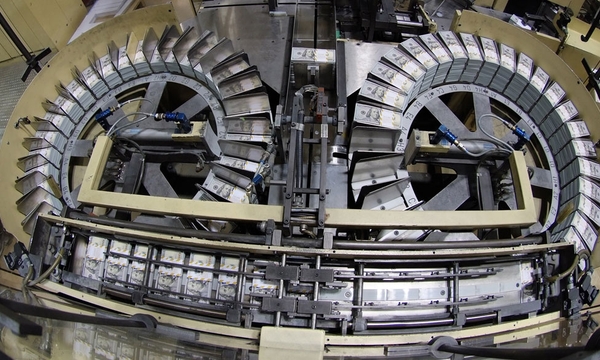
The Currency Overprinting Processing Equipment (COPE) stage is a crucial part of the currency production process, where final details such as serial numbers and Treasury seals are added to the notes.
The Role of COPE in Currency Production
COPE is a sophisticated system used to overprint serial numbers, the Federal Reserve seal, and the Treasury seal on each note. These elements are essential for both the identification and authentication of the currency. The serial numbers provide a unique identifier for each note, while the seals are important symbols of authenticity and government backing.
Adding Serial Numbers and Seals
The process involves precise printing techniques to ensure that the serial numbers and seals are perfectly aligned and clearly printed. The ink used for overprinting is specially formulated to be distinct and durable, ensuring that these critical elements remain legible throughout the life of the note.
Integration in the Production Line
COPE is seamlessly integrated into the currency production line. After the notes have passed through the offset and plate printing stages and have been inspected, they move to the COPE machines. Here, the overprinting is done at high speeds, with each note being individually processed to ensure accuracy and consistency.
Ensuring Accuracy and Security
The accuracy of the COPE stage is vital for the overall security of the currency. Any errors in serial numbers or seals could compromise the integrity of the notes. The equipment used is, therefore, highly sophisticated, equipped with systems to verify the accuracy of each overprint. Any notes that do not meet the stringent standards are automatically rejected and removed from the production line.
The COPE stage represents one of the final steps in the journey of currency production, where the notes receive their unique identifiers and official markings. This stage underscores the blend of high-speed production with precision and security, ensuring that each note is ready for the final steps of cutting, packaging, and eventual circulation.
Large Examining Printing Equipment (LEPE): Enhancing Efficiency and Accuracy
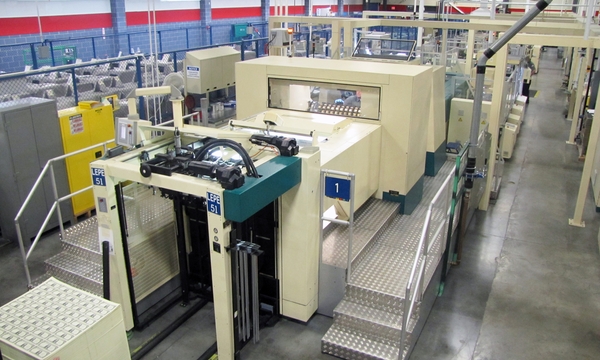
The Large Examining Printing Equipment (LEPE) is a pivotal stage in modern currency production, representing a significant advancement in the efficiency and accuracy of printing and examining U.S. currency notes.
Introduction to LEPE and Its Functions
LEPE is a state-of-the-art system that combines printing, cutting, and examining processes. It is designed to handle large sheets of currency, increasing the speed and efficiency of production. The system is equipped with advanced technology that allows it to perform multiple functions simultaneously, streamlining the production process.
Improving Efficiency and Accuracy
One of the key advantages of LEPE is its ability to improve both efficiency and accuracy in currency production. The system can print more notes in less time compared to traditional methods, while also maintaining high standards of quality. Its integrated examining capabilities ensure that each note meets the stringent requirements for security and aesthetics.
The Role of LEPE in Modern Currency Production
LEPE plays a crucial role in modernizing the currency production process. It represents a shift towards more automated, high-volume production methods, which are essential for meeting the demands of a modern economy. The equipment’s precision and reliability make it an invaluable asset in the production of high-quality, secure currency.
Enhancing Security Measures
In addition to its printing and examining functions, LEPE also enhances the security measures of the currency. It is equipped with sophisticated detection systems that scrutinize each note for any discrepancies or defects. This ensures that every note that passes through the LEPE system is consistent with the required security standards.
The introduction of LEPE in the currency production process marks a significant step forward in terms of efficiency, accuracy, and security. This advanced equipment ensures that the U.S. can produce currency that meets the needs of the modern world, combining speed and volume with the unwavering commitment to quality and security that is essential in currency production.
Packaging: The Final Step in Currency Production
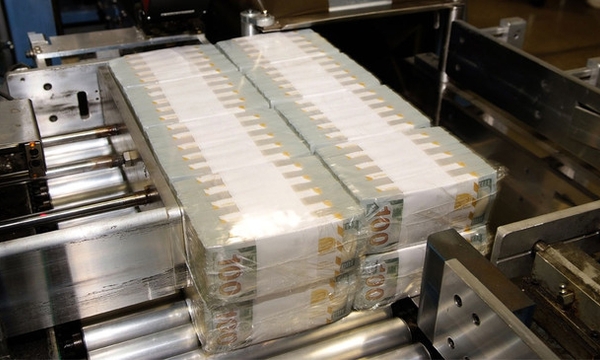
The packaging stage is the final step in the currency production process, where the printed and inspected notes are prepared for distribution. This phase is crucial for ensuring the safe and secure delivery of currency to financial institutions across the country.
Cutting and Sorting
Once the currency sheets have passed through the LEPE system, they are cut into individual notes. This cutting process is highly precise, ensuring that each note is of the correct size and shape. After cutting, the notes are sorted based on denomination and quality. Any notes that do not meet the stringent standards are removed and destroyed.
Bundling and Packaging
The sorted notes are then bundled and packaged for distribution. Bundling is typically done in stacks of 100 notes, which are then wrapped and labeled. These bundles are further packaged into larger containers, often with security features to prevent tampering or theft during transportation.
Security Measures in Transportation
The transportation of currency from the production facilities to banks and other financial institutions is a highly secure process. The packaged currency is transported in armored vehicles, and the routes and schedules are often varied to enhance security. The entire process is closely monitored to ensure the safe delivery of the currency.
The Role of Packaging in Currency Circulation
Packaging plays a vital role in the efficient circulation of currency. It ensures that the notes reach their destinations in pristine condition, ready for use by the public. The packaging process is designed to be both secure and efficient, facilitating the smooth flow of currency into the economy.
The completion of the packaging stage marks the end of the currency production process. From the initial design to the final packaging, each step is carried out with precision and care, ensuring that the currency not only serves as a medium of exchange but also as a symbol of trust and reliability in the financial system. The packaged notes are now ready to enter circulation, facilitating transactions and contributing to the economic activity of the nation.
Conclusion: The Art and Science of Making U.S. Currency
The process of creating U.S. currency is a remarkable blend of art, technology, and meticulous attention to detail. From the initial design phase to the final packaging, each step in the production of currency is crucial in ensuring that the notes not only serve as a reliable medium of exchange but also embody the highest standards of security and aesthetic appeal.
Recap of the Currency Production Process
The journey begins with the designing phase, where artists and security experts collaborate to create a visually appealing and secure design. This is followed by the engraving and siderography stages, where these designs are meticulously transferred onto metal plates. The platemaking process then prepares these plates for printing.
In the printing stages, offset printing lays down the foundational colors and patterns, while plate printing adds the intricate details and tactile features. The inspection process ensures that each note meets stringent quality and security standards. The COPE and LEPE systems add the final touches, including serial numbers and seals, enhancing both efficiency and accuracy.
The Blend of Art and Technology
The production of currency is a testament to the harmonious blend of artistic skill and advanced technology. The intricate designs, precise printing techniques, and sophisticated security measures all reflect the artistry and innovation involved in currency production.
The Evolution of Currency Production Methods
Over the years, the methods and technologies used in currency production have evolved significantly. The transition from hand-engraving to digital methods, the adoption of advanced printing and inspection equipment, and the integration of complex security features are all indicative of this continuous evolution.
The Role of Currency in Society
Finally, it’s important to recognize the role of currency in society. Beyond its practical use as a medium of exchange, currency is a symbol of the nation’s economy and a representation of its history and values. The effort and resources invested in its production reflect its importance in everyday life.
In conclusion, the production of U.S. currency is a complex and fascinating process that combines historical craftsmanship with modern technology. It ensures that the currency in circulation is not just functional but also a work of art, worthy of the trust it commands in the global economy. As technology and security needs evolve, so too will the methods of currency production, continuing the legacy of innovation and excellence in this essential field.